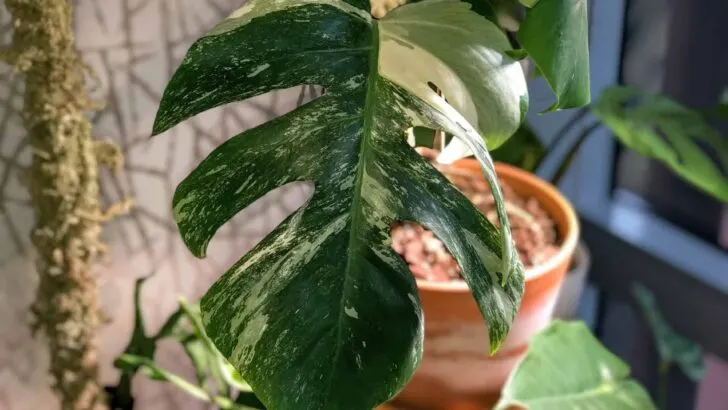Let’s talk about the care for the Variegated Monstera Deliciosa. It is the variegated form of the Monstera Deliciosa.
There is yellow, green, and white variegation on Monstera Deliciosa. The white variegation is the more common form.
Monstera deliciosa Variegata Takeaways
| Species | Monstera deliciosa Variegata |
| Synonyms | Monstera Variegata, Monstera albo, Monstera albo borsigiana |
| Family | Araceae |
| Genus | Monstera |
| Growth | Vining, climbing |
| Height | 10 feet |
| Width | 12 feet |
| Soil | Airy aroid mix containing peat, perlite, charchoal, orchid bark and potting soil. |
| Watering | Every 7-10 days |
| Light | Bright indirect |
| Temperature | 65-80 °F (18-27 °C) |
| Humidity | 50-70% |
| Fertilizer | Fertilize monthly in spring and summer |
| Propagation | Stem cuttings, seeds |
| Toxicity | Toxic to cats and dogs as well as humans. Contains calcium oxalate chrystals |
Find a free care guide infographic at the end of this article.
Variegated Monstera Deliciosa Care
The Variegated Monstera Deliciosa thrives in increased humidity above 60%, well-draining soil, bright indirect light, and temperatures between 65-80ºF (18-27ºC). Fertilize monthly with a liquid fertilizer at half-strength during spring and summer. Use a good balanced 20-20-20 NPK fertilizer. Do not fertilize in the autumn and winter months.
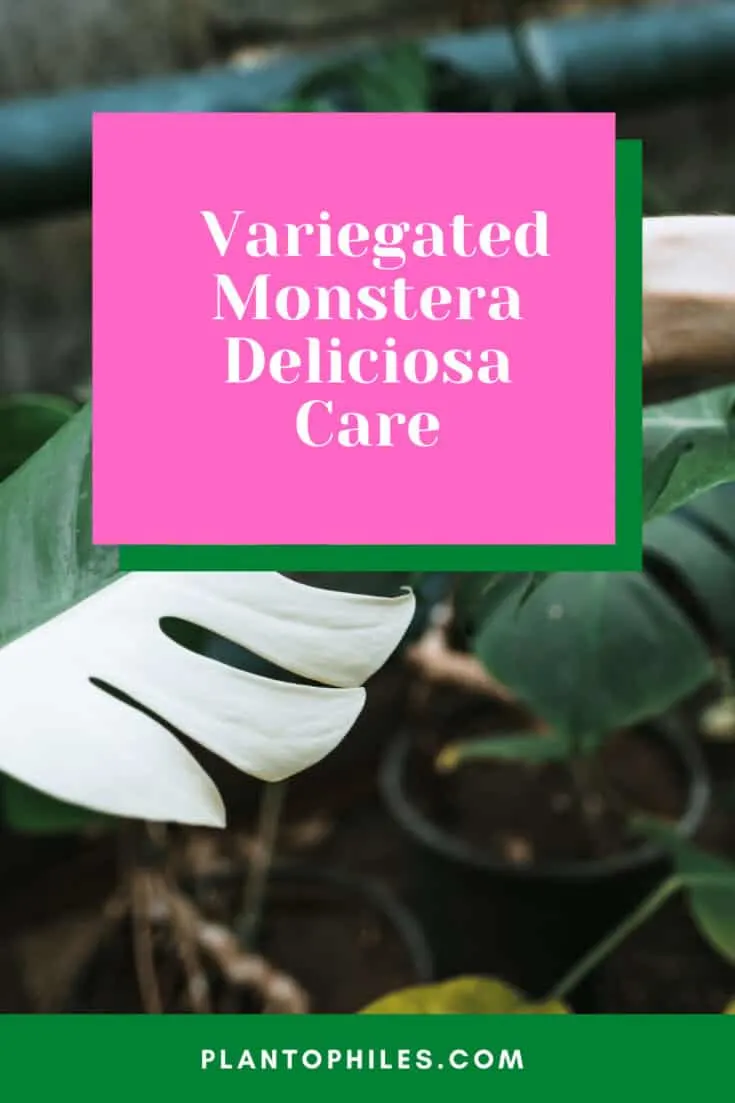
Table of Contents
Monstera Deliciosa Albo Care Video
Variegated Monstera deliciosa borsigiana
To be exact we are talking about the Variegated Monstera Deliciosa var. Borsigiana.
According to the University of Connecticut, it is a climbing vine that needs a totem or moss pole as a support to grow well as a houseplant.
Borsigiana is a smaller version of the Deliciosa.
It is growing quickly but remains smaller than the Monstera Deliciosa.
The Deliciosa is developing huge leaves while Borsigiana leaves stay rather small.
The Variegated Monstera Deliciosa is a flowering plant that is producing fruit and belongs to the Araceae family according to the University of Florida.
It is therefore considered to be an Aroid.
Different examples of plants belonging to the Aroid family are the Monstera Obliqua and Monstera adansonii.
The name “deliciosa” or delicious in English, derives from the fruit of the Monstera, which tastes like a mix between banana and pineapple and is considered a delicacy.
Monstera Deliciosa, or Swiss cheese plant as it is commonly called, is an epiphyte, meaning that it can grow on other plants.
It inhabits rainforests in South America.
The foliage is stunning as the split leaves are often spotted in home decor magazines and Instagram posts in the last couple of years.
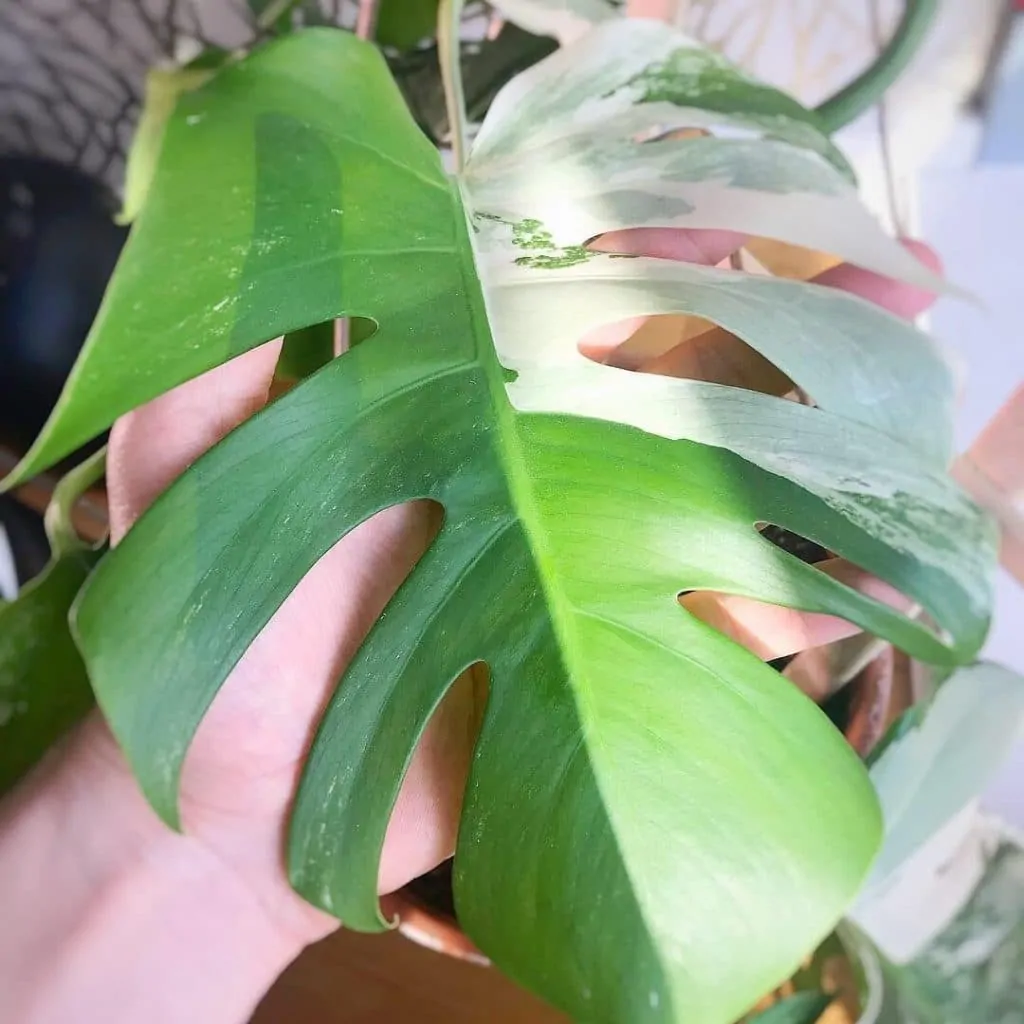
The most common explanation for the split leaves and holes is that the plants must withstand heavy rain and wind.
The gaps and slits are thought to enable the plants to endure these conditions better as there is space for wind and water to pass through without ripping the leaves apart.
It is only a theory at the current stage and not proven.
Difference between Variegated Monstera Deliciosa and Borsigiana
In addition, an important differentiator between the two plants is the ruffled stems where the stem meets the leaf on the Monstera Deliciosa once they are more mature.
Some Monstera Borsigiana does also develop ruffles on the petioles when they mature.
However, a Monstera Deliciosa without a ruffle on the petioles where it meets the leaf blade is not a large form of Monstera deliciosa.
Borisigana is vining, has petioles, and leaves wider apart than the Deliciosa.
The Deliciosa has a much shorter distance between petioles, the parts or stems that hold the leaves.
The internodal distance is the best way to differentiate the two.
Main differences between Monstera Deliciosa and Monstera Deliciosa var. Borsigiana summarized.
The large form Monstera Deliciosa:
- Grows larger with larger leaves
- Smaller internodal spacing
- Has always ruffles on the petioles where they meet the leaf in its mature form
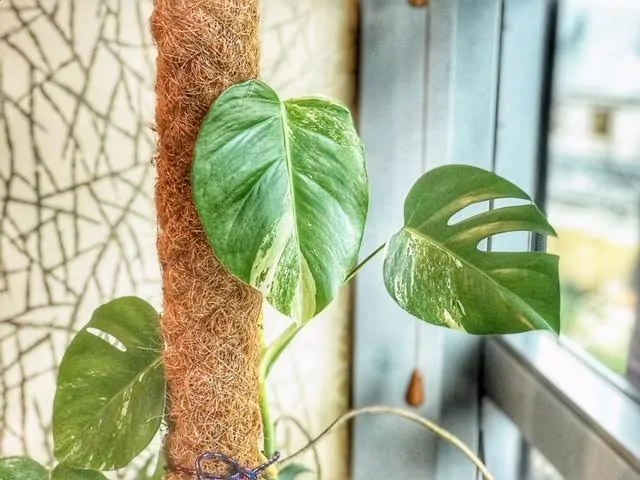
Variegation
After differentiating between these two plants let’s talk about variegation quickly.
Variegation is a lack of chlorophyll. The most common form of the
Variegated Monstera deliciosa is the white form called albo variegated.
There also is a yellow variegated form called Monstera Deliciosa Borsigiana Aurea.
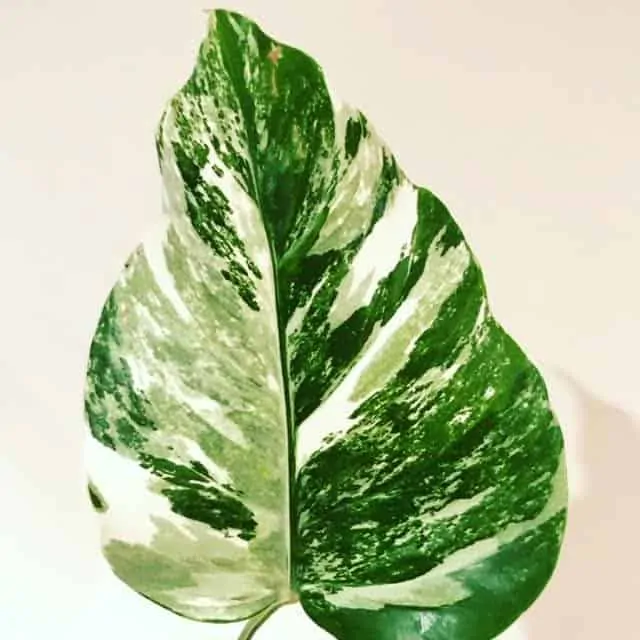
The care of the Variegated Monstera Deliciosa is not difficult at all as long as you are following some general rules and are not overwatering or underwatering too much.
Let’s now look into the Monstera Deliciosa Variegata (Borsigiana) care:
Variegated Monstera Deliciosa Care Guide
Soil
Variegated Monstera Deliciosa thrives in well-draining potting soil.
Adding perlite and orchid bark is a great way to add extra drainage for your Monstera Deliciosa.
Additional components of an excellent aroid mix are charcoal, peat moss, and pumice.
Light
Bright indirect light is best for a Variegated Monstera Deliciosa.
A couple hours of direct sunlight in the morning is fine but be careful. Too much direct light can burn and thus damage the leaves. When dealing with a Variegated Monstera Deliciosa, your plant needs more light than the non-variegated green version.
Because of the white surface area, your Deliciosa has less chlorophyll in its leaves that can be used for photosynthesis.
Watering
Water the Variegated Monstera Deliciosa about once a week. It does not like to stay wet for too long.
Water as you would water most of your houseplants.
About once a week is sufficient in most conditions. Make sure that the water is draining quickly and keep it slightly damp.
The Variegated Monstera Deliciosa does not like to stay wet for too long.
Wait for the soil to dry until you water again.
Your plant will forgive you too much water once or twice but will develop root rot at some point if the roots stay too wet for too long.
It is best to keep the soil slightly moist but never soggy.
Temperature
The best temperature range for a Variegated Monstera Deliciosa is 65-80ºF (18-27ºC).
Temperatures below 50ºF (10ºC) for too long will damage your plant and stop its growth.
Humidity
Provide a humidity of 50% or higher for Variegated Monstera Deliciosa.
The Variegated Monstera Deliciosa loves high humidity.
Some people spray their plants every day.
The Deliciosa flourishes in high humidity but also tolerates it when you are not spraying your plant.
The humidity requirements for the variegated version are even higher than for the pure green variant.
Fertilizer
Fertilize a Variegated Monstera Deliciosa once a month in spring and summer with a liquid houseplant fertilizer and use half of the proposed strength.
Do not fertilize in winter and autumn, when the Variegated Monstera Deliciosa is not in growth mode. Use a well-balanced fertilizer with 20-20-20 NPK values.
Propagation
The Variegated Monstera Deliciosa is the perfect plant for propagation as it is fairly easy to do so. The most common method is taking stem cuttings.
This is also the only way to ensure that you are getting a perfect clone of your plant that is variegated. Propagation from seeds will usually not lead to variegated plants as the variegation is not passed on.
Growth
The Variegated Monstera Deliciosa can grow about 10 feet high.
The Monstera plants produce air or aerial roots that are helping the plant to fixate on other plants and trees. If you provide your Swiss cheese plant with a moss pole the leaves will grow bigger and the stems will grow thicker and higher.
The leaves of the Variegated Monstera Deliciosa are green with white or yellow variegation.
The amount of variegation varies greatly among plants.
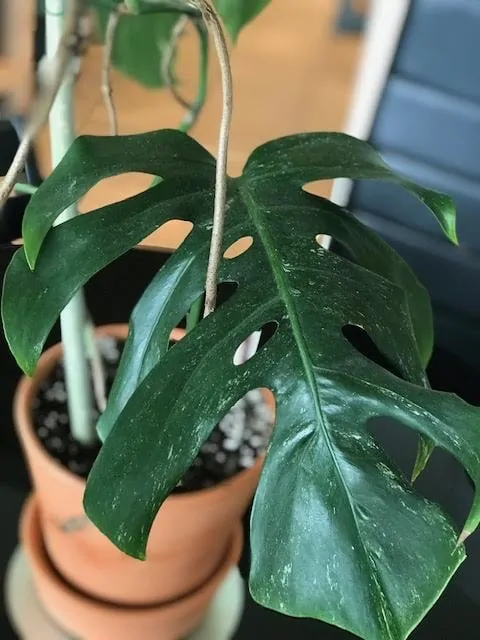
Some Monstera plants have very little white while others have big splashes that almost look like someone spilled a bucket of white paint on them.
If a Variegated Monstera Deliciosa has half-white half green leaves it is called half-moon variegation and is considered even rarer than the already pretty rare and hard-to-find Variegated Monstera Deliciosa.
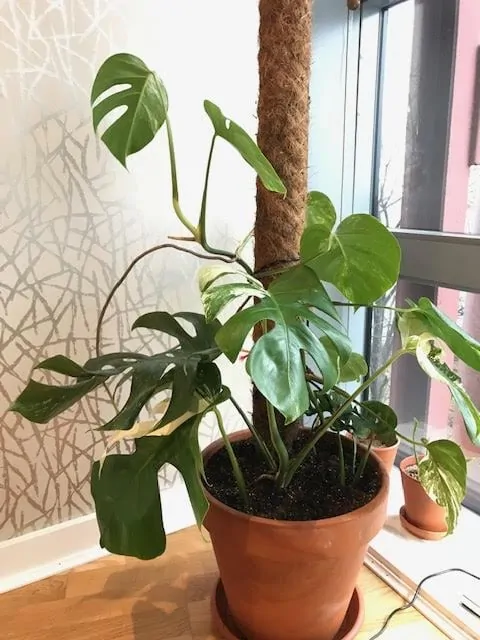
Potting
Use a pot with drainage for a Variegated Monstera Deliciosa.
A drainage hole at the bottom of the pot is just fine as it will prevent soil from staying humid for too long.
Variegated Monstera Deliciosa care is not too different from the care of other tropical houseplants.
The biggest difference we would like to point out is the increased need for light due to the need to compensate for the lack of chlorophyll.
Dim light conditions are not recommended for the Variegated Monstera Deliciosa care.
The leaves of the Variegated Monstera Deliciosa
The leaves of a mature Variegated Monstera Deliciosa are split with slits and holes.
Young plants do not have this characteristic as they develop more and more slits and holes as they mature.
The variegation is on the stem as well as on the leaves. The plant can revert and turn entirely green again.
The opposite is also possible, namely that the Variegated Monstera Deliciosa is becoming whiter and whiter as it grows.
Once it is producing fully white leaves called ghost leaves, it will need to be cut back as no leaves also mean no chlorophyll and no photosynthesis.
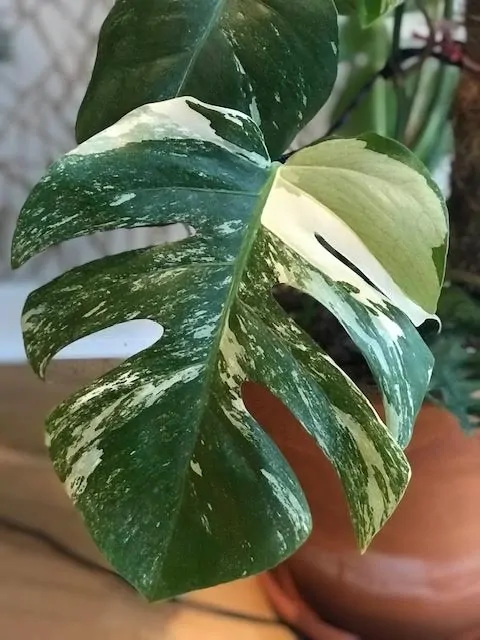
You can cut a Variegated Monstera Deliciosa once it grows in the direction of either growing more white or greener in its leaves and stem.
You have to cut back to the point where stems and leaves have the right ratio.
Make sure that cuttings always have at least a node as this is needed to produce new plants from the cuttings you can propagate.
Lets now talk more in-depth about ways to propagate the Variegated Monstera Deliciosa:
Variegated Monstera Deliciosa Propagation
Monstera Deliciosa can be propagated from seeds or stem cuttings.
However, Variegated Monstera Deliciosas are almost exclusively produced from stem cuttings as the propagation from seeds is not successful.
The same applies to tissue culturing Variegated Monstera Deliciosa. This method does not work to produce variegated plants.
Stem Cuttings
Your best method to get variegated plants is to do stem cutting as this method will always produce an exact clone of the mother plant.
Here are the steps for successful stem propagation:
- Find a section you want to propagate on your Variegated Monstera Deliciosa
- Make sure that you have a section with at least one node, as only these sections can produce viable plants
- Prepare a clean knife or scissors that are free from pesticides and other contamination by using rubbing alcohol and by holding the blade under a hot flame for a few seconds.
- Cut below the node and ensure a section with at least 1-3 leaves. These cuttings will develop way quicker than a section without any leaves. Stems with nodes are also able to produce new plants, but the production will need to go into producing leave and also roots and are starting with no leaves that can produce energy by doing photosynthesis.
- Once you cut the stem, let it dry out for at least a couple of hours up to a day or two, depending on the size of the stem.
- Now that you snipped a section off your Variegated Monstera Deliciosa, it is time for the next medium that will enable the cutting to grow roots and new leaves.
- You can use one of the following mediums: soil, water, sphagnum moss, and perlite.
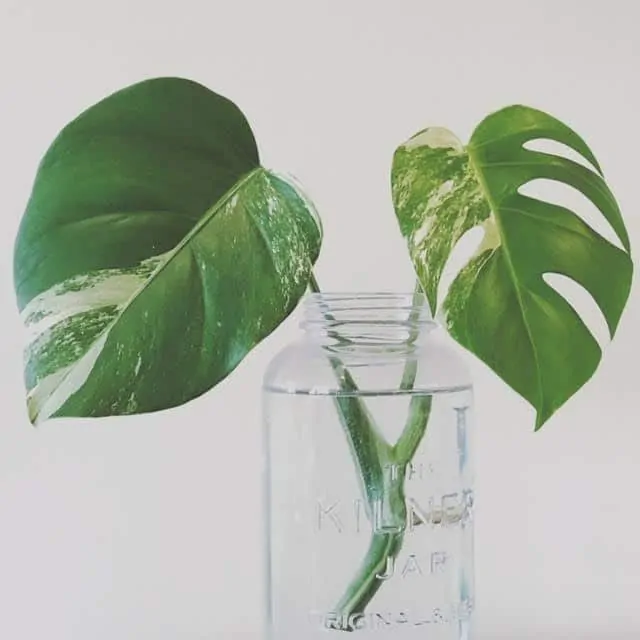
Propagating Variegated Monstera deliciosa in soil
The propagation in soil, from our point of view, can be the easiest but also the hardest method.
For this propagation method, you are preparing well-draining potting soil.
An exemplary mix could be houseplant soil, perlite, and orchid bark.
Water it and make sure it is damp but not soaking wet.
Use an instrument to poke a hole in it and then place your stem cutting in by slowly covering the stem in soil on the side.
Ensure the node is in the soil and the cutting is well-positioned.
That is essentially it. Water from time to time when the soil is dry and ensure it is never drying out.
However, ensure you are not overdoing it as your cutting has no roots to take up water at this stage.
Depending on the season, it may take several weeks to a month for the first roots to grow.
The best indicator that your cutting is growing into a new plant is when it starts producing a new leaf.
A different method to check on your cutting is to try to gently pull it.
If there is resistance, there is a good chance that it started to root.
As I have said I consider this method to be the hardest and easiest method.
I consider it easy because you do not have much to do or to prepare as you are sticking your Variegated Monstera Deliciosa straight into the soil after the cutting had time to callous over (dry).
Some people recommend putting either honey or cinnamon on the cutting as they can act as disinfectants (at least the cinnamon) and are said to promote root growth.
We consider soil propagation to be the hardest method since you have no visibility on what is going on underneath.
You need to be very good at reading the condition of your cutting, as you will not see when your Variegated Monstera Deliciosa cutting is putting out roots.
In addition, if you are watering the soil too much the chances that the cutting is starting to rot is quite high.
Propagating Variegated Monstera deliciosa in water
Water propagation is often considered the method for the plant propagation beginner.
The biggest advantage for sure is that can see what is going on. Using a transparent container you can watch your cutting grow roots.
One thing to mention is that water roots are different from soil roots.
This is also the biggest disadvantage of water propagation. Water roots are not the same as soil roots.
When you put the rooted Variegated Cheese plant into the soil, the plant is in shock and has to produce soil roots first.
Water roots look different than soil roots. Water roots are white and look somewhat like pale spaghetti whereas soil roots are brown to black and often thicker and harder.
However, once the transition from water to soil has happened, the Monstera usually grows without any hiccups or issues.
In the next section, we will look at our preferred propagation method.
Propagation using sphagnum moss.
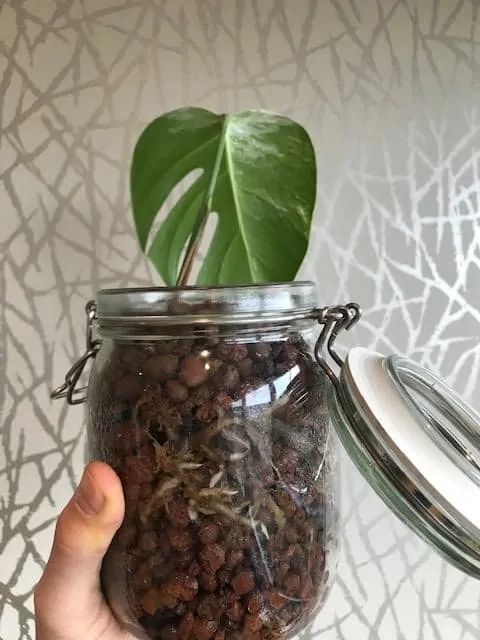
Propagating Variegated Monstera deliciosa in Sphagnum Moss
Sphagnum Moss is the easiest method from our point of view and produces the best roots the quickest.
As Sphagnum Moss encourages soil roots, there is no show when placing the rooted cuttings into the soil where they belong.
That is a big advantage over rooting Variegated Monsteras in water.
You can either use fresh living sphagnum moss or dried-up moss. Both methods work.
The best sphagnum moss is New Zealand long-fiber sphagnum moss but any sphag. moss will do.
Before your place your cutting into the moss, water it thoroughly or let it soak in water.
This specifically applies to dried-up moss. Moss is said to take up 16 times its weight in water.
In addition, sphagnum moss is said to have antibacterial properties and can help to prevent root rot.
The perfect combination for propagation.
The trick with sphagnum moss is that it should not be too wet.
If you keep your moss too wet, your cutting will remain in soaking-wet conditions and will start to show signs of root rot.
At this point, it means downhill for your Variegated Monstera cutting, and you will have to save it from rotting entirely.
Propagating Variegated Monstera deliciosa in perlite
A rather new method that we read about more and more is to do the propagation or rooting process in Perlite.
As perlite is inorganic, there is the slimmest chance for rootings to produce rot as it is porous and well-draining, allowing airflow.
These capabilities make sure humidity evaporates quickly before it allows rot to form.
One thing to be aware of is that you need to transfer your cutting into the soil once it starts to root.
To use perlite for a monstera Deliciosa Variegata, make sure it is slightly moist but not entirely wet.
Fill a container whilst placing perlite around your cutting and firmly press it against the stem.
Since perlite is lighter than soil, you will need to put your cutting a bit deeper than when you would put it into the soil to enable it to stand upright.
Avoid too much sunlight or artificial light, as the cuttings have no roots to take up water.
In addition, make sure that the temperature is not too hot in the area where you place the cutting for the same reason.
Mist from time to time to ensure that the perlite stays slightly moist.
Hold back on watering and err on caution as watering too much could cause root rot.
As said, once the cuttings have produced roots, they have to be transferred to soil as the perlite contains little to no nutrients.
Common Variegated Monstera Deliciosa Problems
Monstera Deliciosa Variegata quickly looks bad if your houseplant care is not at its best. These are the most common problems and remedies:
Browning leaves
Problem: Browning and yellowing leaves can be an indicator of overwatering and having the ratio between watering and light not in check.
Specifically, the browning of the white variegation areas is caused by insufficient light and also humidity.
Some people claim it to be normal, but it can certainly be prevented as we guess you would love to keep the white parts on your precious variegata.
Solution: Reduce watering and make sure your Variegated Monstera Deliciosa Borsigiana gets enough light.
Cut away the brown parts on the leave and white areas as this will help to reduce the chance for the browning to spread on the leaves.
Yellowing leaves
Problem: The most common cause of yellowing leaves on a Monstera Deliciosa Variegata is overwatering.
Overwatering is so common with houseplants that most people will not even realize they are overwatering. In addition, it doesn’t always mean you are watering too much.
If you use a pot with no drainage holes or potting soil that is too dense and not chunky enough roots will stay moist for too long and will not get enough oxygen.
Your plant will tell you this by leaves turning yellow.
A different reason for yellowing leaves is when old leaves are about to fall off. This is when mostly single leaves will first yellow and then wilt.
Solution: Check the soil and also the roots of your plant. If your soil is still soaking wet a week after watering, you need to change your soil mix/pot or both.
If roots start to rot, you must remove the rooted sections to prevent rotting from spreading further. Water less.
Brown leaf tips
Problem: The most common cause is not enough humidity and dry air. Pot-bound plants can also cause leaf tips to brown.
Solution: Spray the leaves of your variegated Monstera Deliciosa plant daily.
Use a pebble tray underneath the plant pot and fill it with water. If a Monstera is pot-bound, switch to a bigger pot.
Mites and Scale infection
Problem: Tiny animals on your Variegated Monstera Deliciosa.
Mites are nasty plant sap-sucking creatures that suck plant sap from the underside of plant leaves.
These pests can potentially destroy a plant if they occur in large populations.
Look for drops and accumulations of tiny animals on the underside of your Variegated Monstera leaves.
Scale insects are easy to spot when mature. They are brown to black and also suck on the sugar secret of the plant sap.
Once they are mature, they are quite easy to spot with your bare eyes due to their size.
There are different types of scales. Another scale type is the white scale.
Solution: Spray your plant with a diluted soap or alcohol solution.
Some people recommend neem oil. If nothing else works, use bug spray to prevent further spread to other plants.
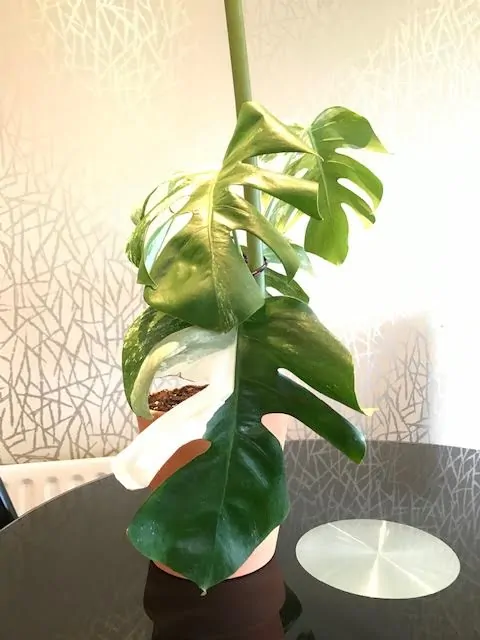
Frequently Asked Questions
How do I care for a variegated Monstera Deliciosa?
The Variegated Monstera Deliciosa care is similar to that of a regular Monstera Deliciosa regarding soil, temperature, and watering needs. The most significant difference is that they need more light because the plants are varied and even more humidity to ensure the white variegated parts are not browning.
What do I do if the white parts on a Variegated Monstera Deliciosa are browning?
Increase the humidity in the room by spraying water on the leaves of your Variegated Monstera daily, putting a pebble tray below the pot, or using a humidifier. Make sure your Cheese plant is getting enough bright indirect light. Use scissors to remove the browning part on the leaves to prevent further browning. Cut the natural shape of the leaves.
Can you grow variegated monstera from seed?
This is highly unlikely. In most cases, variegated Monstera deliciosa is not passing on this trait through seeds. A better way is to make stem cutting as they are exact clones of the mother plant.
Where can I buy a Variegated Monstera Deliciosa?
Although Variegated Monsteras are rare, they are found increasingly in garden centers in different countries. Your best sources to buy one are still: Etsy, eBay, and Facebook, as well as boutique online plant stores.
How much does a Variegated Monstera Deliciosa cost?
Prices range tremendously for these plants. The biggest factors seem to be where you are located. New Zealand, Australia, and the USA are countries where you pay a big premium. Specifically, in the first two countries, it is not seldom to see Monstera deliciosa prices between $300 – 600 for a mature Monstera deliciosa specimen. Monstera Deliciosa Variegata is becoming more readily available in Europe, but you are still paying between $50-$100 for just cutting with 1-3 leaves.
Will the price for a Variegated Monstera Deliciosa decrease over time?
As with almost everything else, economics also applies in the plant business. It is about supply and demand. The demand is still much higher than the supply. The more people get a Variegated Monstera Deliciosa; the more cuttings will become available. But as you cannot produce variegation from seeds in most cases and you cannot tissue culture Variegated Monsteras, it will take time for prices to fall.
Are there any true Variegated Monstera Deliciosa and not Borsigiana?
Yes, there are. The true Deliciosa form is a bigger plant with bigger leaves and certain differences, such as ruffled stems where the stem meets the leaf. Although they are much more difficult to find, there are also variegated versions of the bigger brother, the true Monstera Deliciosa, not Monstera Deliciosa Borsigiana.
DOWNLOAD THE FREE VARIEGATED MONSTERA DELICIOSA INFOGRAPHIC
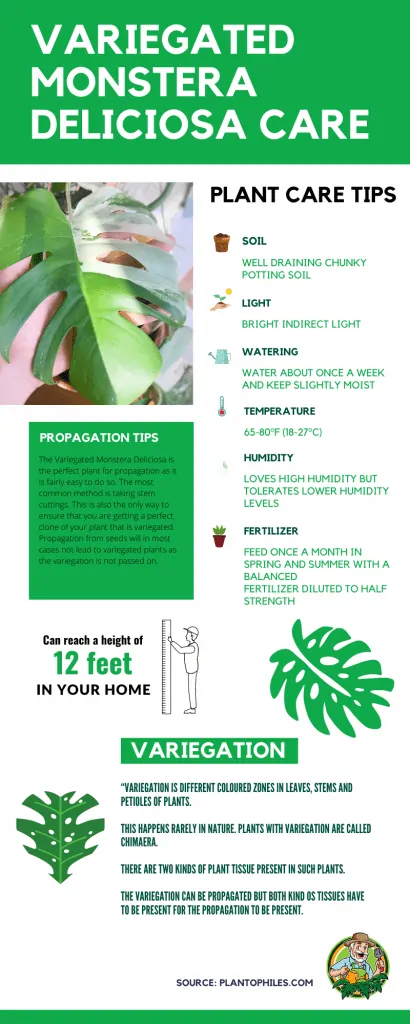

Daniel has been a plant enthusiast for over 20 years. He owns hundreds of houseplants and prepares for the chili growing seasons yearly with great anticipation. His favorite plants are plant species in the Araceae family, such as Monstera, Philodendron, and Anthurium. He also loves gardening and is growing hot peppers, tomatoes, and many more vegetables.

